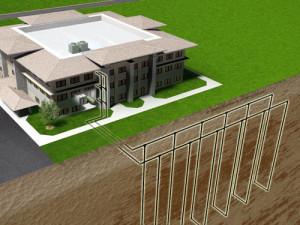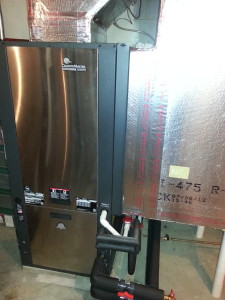Geothermal Systems
No matter what kind of system you like, when the topic of efficiency comes up, only one word can be said. Geothermal.
Geothermal uses the earths thermal energy to keep your home warm in the winter and cool in the summer. Buts that’s not it, your geothermal system can also give you free hot water for your kitchen or bath, and even your swimming pool depending on the model of unit. And if you are a business owner or have a large scale project, no worries, geothermal can be fit into almost any commercial application as well.
Lets take a closer look. No matter the time of year, the earth will maintain a constant temperature of about 52 to 55 Degrees. What a geothermal system will do is use this energy in the ground to heat or cool your building. A geothermal system must have a few components in order to operate. First, the Ground and Water. The water that will be pumped into your building is what will be transferring the heat. When it comes to getting that water into the building we can do this a few ways. By a water well and rejection well (Open Loop), A series of pipe loops under the ground (Closed Loop), or By means of a pond or cooling tower (Commercial Applications). Second of course will be the Geothermal Unit itself and Water Pumps. This is what will take that ground energy and transfer it into usable heat, by means of heat exchangers, compressors, valves, and pumps. And Third is heat distribution system. This can either be ductwork throughout the building or subfloor piping (Radiant Heat). After we have taken a good look at the building and property, we can then decide what is the most economical way to transfer heat from the ground to the building.
If you are considering replacing your current heating and air conditioning system, or looking to upgrade from your existing heat source, what are your options.Have a gas or oil fired boiler? This could be one of the most costly renovations of all. this is because not only will we be installing the loop field in your backyard, and setting the geothermal unit in your basement, but we will also need to install all of your ductwork throughout the building. now for new construction, this is no problem at all, but with an existing home, this is quite a different situation. the ductwork layout will certainly play a large role in the overall cost of the install.
Have a gas or oil fired furnace? This situation we encounter most often. Again we will need to do all the same work in your backyard as with any install, and we will have to set a geothermal unit in your basement too, but as opposed to converting a boiler building to geothermal, with a furnace/ Air Conditioning upgrade, it is possible to use the existing ductwork. that is, if the existing ductwork is sized correctly for the new unit. With this in mind, if the ductwork does not require major renovation, you can be saving even more money by switching to geothermal.
Building a new House? This situation is really a no brainer. If the total installed cost of a Geothermal system can be added into a mortgage and spread over a 15 or 30 year period, you may never feel the shock of upfront costs. In almost every new building situation we find that when compared to any other type of HVAC system, you will start seeing a return on investment day 1. For example, lets say that you are planning a new house build and are considering a geothermal HVAC system and a conventional propane gas and AC system. First, lets say that your mortgage payment every month on a conventional system is $1,400 per month, as opposed to a geothermal system which may bring our monthly mortgage payment to about $1,444. Now, if we look into operation cost we notice that a conventional HVAC system will cost about $3,000 per year (average $250 per month), where as a geothermal system can cost about $1,300 per year (average $108 per month). So if we take all that information of brake it down, we see that a building with a Conventional HVAC system will cost about $1,650 per month for this example home. Where as the same home with a Geothermal HVAC system will cost about $1,552 per month. That is a savings every month of about $100 starting day 1.
So, You Don’t Have Any Current Source Of Heat, Or Want To Know All Of Your Options? The chart below lists all of your heating and cooling options, as well as gives you an idea of Installation Cost and Operation Costs compared to one another.
| Heat Source | Cooling Source | Notes | New Install | Operation |
| Oil Boiler | A/C | Requires Boiler & All Water Piping + Air Handler and Ductwork Installed For A/C | $$$$$ | $$$$$ |
| Oil Furnace | A/C | Both Furnace and A/C Use Same Ductwork | $$$ | $$$$$ |
| Gas Boiler | A/C | Requires Boiler & All Water Piping + Air Handler and Ductwork Installed For A/C | $$$$$ | $$$ |
| Gas Furnace | A/C | Both Furnace and A/C Use Same Ductwork | $$$ | $$$ |
| Electric | A/C | Both Furnace and A/C Use Same Ductwork | $ | $$$$$ |
| Heat Pump | One Unit Does It All, But Must Have A Backup Heat Source, Usually Electric | $$$ | $$$ | |
| Geothermal | One Unit Does It All, Can Also Produce Free Hot Water, Can Be Used In Radiant Floor Heat | $$$$$$ | $ | |
 Are the savings from installing geothermal going to be worth the cost of conversion?
Are the savings from installing geothermal going to be worth the cost of conversion?
This will really depend on several factors such as; Lot size and accessibility, Age of building, Current heat source/ Ductwork, Water condition, and Size of building. But before we take a shot in the dark hoping that the geothermal system will work. Sandwell will complete a full cost comparison energy analysis for your building. What this will do is let you know is, not only what you a currently paying just to heat and cool your home, but also how much it will cost you to operate a geothermal system each year, as well as exactly when the geothermal system will have paid for itself with all of the monthly savings. This can vary anywhere from 15 years to as low as 4 years.
